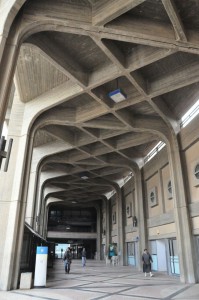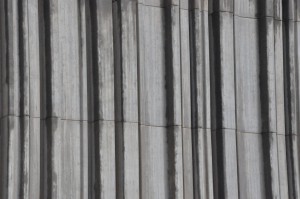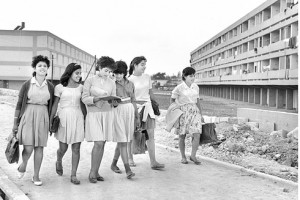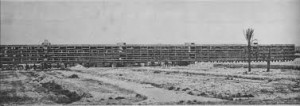Le Corbusier was a well-known architect who designed in many ways, the foundations of architecture and building systems in the way we are observing it today. Le Corbusier was one of the first architects who has developed the way to take advantage of concrete. His modern building designs were inspired by his vision to adapt the architecture to the industrial age. The buildings should “work” as a machine that serves the residents, as he was claiming. He wanted to create utopian structures and surroundings that would fit the working people and provide them the best quality of life. He developed a theory of urban planning based on simple, non-decorated, functional design
Le Corbusier, looking on a scale model made for one of his designs. You could definitely see the connection between it and the Brutalists architecture.
Inspired by his ideals, the Brutalist architecture style was developed. The Brutalist architects were broadly active in Germany, UK, France, Italy, Australia, Israel, Yugoslavia, Japan and the US. Mainly at the first half of the 20th century until the seventies. Brutalist design is characterized by the exposed cement and simple functional structure. The structure supposed to represent the essence of a building, therefore the most important elements are the materials, space and form. The name, Brutalists come from Le Corbusier’s expression (French) – Béton Brut, which means raw concrete.
One example of an utopian Brutalist experience is in Be’er Sheva. “The capital of the desert” in Israel. After Israel was established in 1948 the new government encouraged the building up modern, progressive projects. The new developing country had a lot of new migrants coming from all over the world. Their vision was to make all these people feel and act as one united nation. Even though they were coming from such different backgrounds, they were bound to be as one. As more and more newcomers continued coming, there was a constant need of new buildings. That aspect gave the chance to many architects to bring to life very unusual plans.


Ben Gurion university : Be'er Sheva • A typical .Béton brut (French) raw and concrete wall texture
The leaders on those days believed that they were designing the future society of ideal new kind of people under a socialist narrative. Moreover the architecture was a tool that could represent this ideal society and help shaping it. Therefore they were even dreaming of having a large modern, green, “western” oasis. A city in the desert area, that before that wasn’t as developed or inhabited with many people. To bring the civilization, the great strong structures that represent a progressive, successful society
Women walking at the fifth neighborhood, Be'er Sheva. After it was recently build
One of the most famous projects in the city was designed by Avraham Yaski and Amnon Alecandroni. They were planning a very long building that was part of an utopian neighborhood – a large scaled housing project, called “The Fifth Neighborhood” – in Hebrew “Shouna hei”. This neighborhood was designed as “A Model Neighborhood” and it includes different architectural projects that were supposed to show different kind of modern, progressing attitudes towards the deserts conditions.
The most well known one, that also became as a symbol for Israeli Brutalist building is the Quarter Kilometer Long Building . This project was completed in the 1960s. It used to be considered as the longest block in the Middle East. The Idea was to build such a long building that will block the wind and the dust, then in the surrounding of it they were building up lower houses that enjoyed from protection of the larger structure. Inspired by Le Corbusier the first level is only pilots and is being used as an open space. The building is very geometrical and simple and there are any windows that have a wide conceit frame to differed it from the strong sun shine.
Back then, they were really dreaming about having great life quality, adjusted to the weather conditions. The creators of this building, neighborhood and city believed that they could subjugate the natural conditions of the place if they would just build in the right way. If it would be big enough, massive enough – the desert will surrender to the architecture. They were planning this buildings to be designed and built in high quality standards, for medium class residence. Eventually when utopia meets reality different things happen. Despite the innovative design, this building “has become an urban legend bleak, a magnet for problems and crime.” Avraham Yaski, the leading architect “of the project referred to it as a “conscious tryout that completely failed”
The quarter-kilometer block, today.
The longest block in the middle east. 1960. Be'er Sheva.
Today many people criticize the Brutalist style, claiming that the exposed cement, the rough structures and the simple geometric shapes looks massive, neglected, aggressive, ugly and represent the way the regime was trying to force this unreal utopia version. Building in the same way they where trying to led the people as one machine that needs to serve a certain kind of a national dream.
While wondering about that I find my self split between a respectful, even amazed feeling towards those architects that dared to dream and to try something that was so revolutionary at the time and the feeling that this vision of great wide buildings with European meadow in the desert is so alienated and disconnected from the traditional way of surviving in this landscape
I think that this contradiction represent a very familiar complexity that exists in the Israeli society still today. The contradiction between the utopian vision of being part of the European culture (in that case architecture and urban design) and the fact that the country is based in the middle east, that lots of the civilians are coming from middle eastern, north African countries and that it is surrounded with very reach culture that makes it impossible to fully deny those other influences that pops up and stand against that utopian vision. In a way the quarter kilometer block is a living example for that complexity
A cover of the book: Avraham Yasky, Concrete Architecture. A monograph on Yasky's work by Sharon Rotbard









